Impact of Drought on the Aquatic Ecosystem of the Cascade Dam Reservoir in South Korea
Abstract
1. Introduction
2. Materials and Methods
2.1. Study Area
2.2. Data Sources for Precipitation and Hydrological Factors
2.3. Drought Condition Assessment Using Standardized Precipitation Index (SPI)
2.4. Sample Collection and Water Quality Analysis
2.5. Korean Trophic State Index
2.6. Phytoplankton Analysis
2.7. Statistical Analysis
3. Results and Discussion
3.1. Precipitation and Hydrological Characteristics
3.2. Water Quality Characteristics
3.3. Annual Variation in Phytoplankton Abundance and Characteristics
3.4. CCA of the Phytoplankton Community and Environmental Factors
4. Conclusions
Supplementary Materials
Author Contributions
Funding
Data Availability Statement
Conflicts of Interest
Abbreviations
| BOD | Biological oxygen demand |
| CCA | Canonical correspondence analysis |
| Chl-a | Chlorophyll-a |
| COD | Chemical oxygen demand |
| TOC | Total organic carbon |
| EC | Electrical conductivity |
| DO | Dissolved oxygen |
| TN | Total nitrogen |
| NO3-N | Nitrate |
| NH3-N | Ammonia |
| TP | Total phosphorus |
| PO4-P | Phosphate |
| TSIKO | Korean Trophic State Index |
| SS | Suspended solids |
| WRT | Water residence time |
References
- Mun, Y.-S.; Nam, W.-H.; Jeon, M.-G.; Kim, T.; Hong, E.-M.; Hayes, M.J.; Tsegaye, T. Application of meteorological drought index using Climate Hazards Group InfraRed Precipitation with Station (CHIRPS) based on global satellite-assisted precipitation products in Korea. J. Korean Soc. Agric. Eng. 2019, 61, 1–11. [Google Scholar]
- Mosley, L.M. Drought impacts on the water quality of freshwater systems; review and integration. Earth Sci. Rev. 2015, 140, 203–214. [Google Scholar] [CrossRef]
- Lake, P.S. Drought and Aquatic Ecosystems: Effects and Responses; John Wiley & Sons: Hoboken, NJ, USA, 2011. [Google Scholar]
- Srifa, A.; Phlips, E.J.; Cichra, M.F.; Hendrickson, J.C. Phytoplankton dynamics in a subtropical lake dominated by cyanobacteria: Cyanobacteria ‘Like it Hot’ and sometimes dry. Aquat. Ecol. 2016, 50, 163–174. [Google Scholar]
- Jeppesen, E.; Søndergaard, M.; Jensen, J.P.; Havens, K.E.; Anneville, O.; Carvalho, L.; Coveney, M.F.; Deneke, R.; Dokulil, M.T.; Foy, B. Lake responses to reduced nutrient loading–an analysis of contemporary long-term data from 35 case studies. Freshw. Biol. 2005, 50, 1747–1771. [Google Scholar]
- Marcinkowski, P.; Grygoruk, M. Long-term downstream effects of a dam on a lowland river flow regime: Case study of the Upper Narew. Water 2017, 9, 783. [Google Scholar] [CrossRef]
- Ingole, N.P.; An, K.-G. Modifications of nutrient regime, chlorophyll-a, and trophic state relations in Daechung Reservoir after the construction of an upper dam. J. Ecol. Environ. 2016, 40, 5. [Google Scholar]
- Olsson, F.; Mackay, E.B.; Moore, T.; Barker, P.; Davies, S.; Hall, R.; Spears, B.; Wilkinson, J.; Jones, I.D. Annual water residence time effects on thermal structure: A potential lake restoration measure? J. Environ. Manag. 2022, 314, 115082. [Google Scholar]
- Rocha, M.A.M.; Barros, M.U.; Costa, A.C.; de Assis de Souza Filho, F.; Lima Neto, I.E. Understanding the water quality dynamics in a large tropical reservoir under hydrological drought conditions. Water Air Soil Pollut. 2024, 235, 76. [Google Scholar]
- Bloesch, J. Mechanisms, measurement and importance of sediment resuspension in lakes. Mar. Freshw. Res. 1995, 46, 295–304. [Google Scholar]
- Orihel, D.M.; Baulch, H.M.; Casson, N.J.; North, R.L.; Parsons, C.T.; Seckar, D.C.; Venkiteswaran, J.J. Internal phosphorus loading in Canadian fresh waters: A critical review and data analysis. Can. J. Fish. Aquat. Sci. 2017, 74, 2005–2029. [Google Scholar] [CrossRef]
- Luong, H.A.; Rohlfs, A.-M.; Facey, J.A.; Colville, A.; Mitrovic, S.M. Long-term study of phytoplankton dynamics in a supply reservoir reveals signs of trophic state shift linked to changes in hydrodynamics associated with flow management and extreme events. Water Res. 2024, 256, 121547. [Google Scholar] [PubMed]
- Kim, B.C.; Park, J.H.; Hwana, G.S.; Choi, K.S. Eutrophication of large freshwater ecosystems in Korea. Korean J. Limnol. 1997, 30, 512–517. [Google Scholar]
- Shin, J.-K.; Kang, C.-K.; Kim, H.-S.; Hwang, S.-J. Limnological characteristics of the river-type Paltang Reservoir, Korea: Hydrological and environmental factors. Korean J. Ecol. Environ. 2003, 36, 242–256. [Google Scholar]
- An, K.-G.; Jones, J.R. Factors regulating bluegreen dominance in a reservoir directly influenced by the Asian monsoon. Hydrobiologia 2000, 432, 37–48. [Google Scholar]
- Jung, S.; Shin, M.; Kim, J.; Eum, J.; Lee, Y.; Lee, J.; Choi, Y.; You, K.; Owen, J.; Kim, B. The effects of Asian summer monsoons on algal blooms in reservoirs. Inland Waters 2016, 6, 406–413. [Google Scholar] [CrossRef]
- Kim, D.; Kim, Y.; Kim, B. Simulation of eutrophication in a reservoir by CE-QUAL-W2 for the evaluation of the importance of point sources and summer monsoon. Lake Reserv. Manag. 2019, 35, 64–76. [Google Scholar]
- Jeon, H.-W.; Choi, J.-W.; An, K.-G. Spatio-temporal water quality variations at various streams of Han-River watershed and empirical models of serial impoundment reservoirs. Korean J. Ecol. Environ. 2012, 45, 378–391. [Google Scholar]
- Mamun, M.; Atique, U.; Kim, J.Y.; An, K.-G. Seasonal water quality and algal responses to monsoon-mediated nutrient enrichment, flow regime, drought, and flood in a drinking water reservoir. Int. J. Environ. Res. Public Health 2021, 18, 10714. [Google Scholar] [CrossRef]
- Beaver, J.R.; Casamatta, D.A.; East, T.L.; Havens, K.E.; Rodusky, A.J.; James, R.T.; Tausz, C.E.; Buccier, K.M. Extreme weather events influence the phytoplankton community structure in a large lowland subtropical lake (Lake Okeechobee, Florida, USA). Hydrobiologia 2013, 709, 213–226. [Google Scholar]
- Williamson, C.E.; Saros, J.E.; Vincent, W.F.; Smol, J.P. Lakes and reservoirs as sentinels, integrators, and regulators of climate change. Limnol. Oceanogr. 2009, 54, 2273–2282. [Google Scholar]
- Jang, M.T.G.; Alcântara, E.; Rodrigues, T.; Park, E.; Ogashawara, I.; Marengo, J.A. Increased chlorophyll-a concentration in Barra Bonita reservoir during extreme drought periods. Sci. Total Environ. 2022, 843, 157106. [Google Scholar]
- Knapp, A.S.; Milewski, A.M. Spatiotemporal relationships of phytoplankton blooms, drought, and rainstorms in freshwater reservoirs. Water 2020, 12, 404. [Google Scholar] [CrossRef]
- Grabowska, M.; Mazur-Marzec, H.; Więcko, A. How Extreme Droughts Change the Impact of Eutrophic Reservoir on Its Outflow, with Special References to Planktonic Cyanobacteria and Their Secondary Metabolites? Water 2025, 17, 86. [Google Scholar] [CrossRef]
- Schindler, D.W. Recent advances in the understanding and management of eutrophication. Limnol. Oceanogr. 2006, 51, 356–363. [Google Scholar]
- Kim, J.Y.; Atique, U.; Mamun, M.; An, K.-G. Long-term interannual and seasonal links between the nutrient regime, sestonic chlorophyll and dominant bluegreen algae under the varying intensity of monsoon precipitation in a drinking water reservoir. Int. J. Environ. Res. Public Health 2021, 18, 2871. [Google Scholar] [CrossRef]
- Youn, S.J.; Im, J.K.; Byeon, M.-S.; Yu, S.J. Characteristics of cyanobacteria and odorous compounds production in lake uiam and lower gonji stream. J. Korean Soc. Water Environ. 2019, 35, 99–104. [Google Scholar]
- Byun, J.-H.; Yu, M.; Lee, E.; Yoo, S.-J.; Kim, B.-H.; Byun, M.-S. Temporal and spatial distribution of microbial community and odor compounds in the Bukhan river system. Korean J. Ecol. Environ. 2018, 51, 299–310. [Google Scholar]
- Byun, J.-H.; Hwang, S.J.; Kim, B.K.; Park, J.R.; Lee, J.K.; Lim, B.J. Relationship between a Dense Population of Cyanobacteria and Odorous Compounds in the North Han River System in 2014 and 2015. Korean J. Ecol. Environ. 2015, 48, 263–271. [Google Scholar]
- McKee, T.B.; Doesken, N.J.; Kleist, J. The relationship of drought frequency and duration to time scales. In Proceedings of the 8th Conference on Applied Climatology, Anaheim, CA, USA, 17–22 January 1993; pp. 179–183. [Google Scholar]
- MOE. Standard Methods for the Examination Water Quality; The Korean Ministry of Environment: Sejong, Republic of Korea, 2014. [Google Scholar]
- Kim, B.; Kong, D. Examination of the Applicability of TOC to Korean Trophic State Index (TSI KO). J. Korean Soc. Water Environ. 2019, 35, 271–277. [Google Scholar]
- John, D.M.; Whitton, B.A.; Brook, A.J. The Freshwater Algal Flora of the British Isles: An Identification Guide to Freshwater and Terrestrial Algae; Cambridge University Press: Cambridge, UK, 2002. [Google Scholar]
- Hirose, H.; Yamagishi, T.; Akiyama, M. Illustrations of the Japanese Freshwater Algae; Uchidarokakuho Publ. Co., Ltd.: Tokyo, Japan, 1977. [Google Scholar]
- Krammer, K.; Lange-Bertalot, H. Bacillariophyceae. Naviculaceae. Süßwasserflora von Mitteleuropa; Gustav Fischer Verlag: Stuttgart, Germany, 1986; Volume 1, p. 876. Available online: http://link.springer.com/book/9783827426154 (accessed on 4 September 2023).
- Krammer, K.; Lange-Bertalot, H. Süßwasserflora von Mitteleuropa, Bd 2/2. Bacillariophyceae. 2. Teil: Bacillariaceae, Epithemiaceae, Surirellaceae; Gustav Fischer Verlag: Stuttgart, Germany, 1988. [Google Scholar]
- Krammer, K.; Lange-Bertalot, H. Süßwasserflora von Mitteleuropa, Bd. 02/3: Bacillariophyceae: Teil 3: Centrales, Fragilariaceae, Eunotiaceae; Gustav Fischer Verlag: Stuttgart, Germany, 1991. [Google Scholar]
- Krammer, K.; Lange-Bertalot, H. Süßwasserflora von Mitteleuropa, Bd. 02/4: Bacillariophyceae: Teil 4: Achnanthaceae, Kritische Ergänzungen zu Achnanthes sl, Navicula s. Str., Gomphonema, Gesamtliteraturverzeichnis Teil 1–4, Ergänzter Nachdruck, 2004; Spektrum Akademischer Verlag: Heidelberg, Germany, 1999; Available online: http://link.springer.com/book/9783827408389 (accessed on 4 September 2023).
- Morabito, G.; Oggioni, A.; Caravati, E.; Panzani, P. Seasonal morphological plasticity of phytoplankton in Lago Maggiore (N. Italy). Hydrobiologia 2007, 578, 47–57. [Google Scholar]
- Hu, R.; Han, B.; Naselli-Flores, L. Comparing biological classifications of freshwater phytoplankton: A case study from South China. Hydrobiologia 2013, 701, 219–233. [Google Scholar]
- Schilstra, M.; Wang, W.; van Oel, P.R.; Wang, J.; Cheng, H. The effects of reservoir storage and water use on the upstream–downstream drought propagation. J. Hydrol. 2024, 631, 130668. [Google Scholar]
- Lin, Y.-I.; Pan, S.-Y.; Chang, H.-H.; Yu, M.-S.; Lin, W.-L. Will extreme drought impact the reservoir water quality? A 30-year observational study. Agric. Water Manag. 2023, 289, 108574. [Google Scholar]
- Moon, Y.-E.; Kim, H.-S. Inter-Annual and seasonal variations of water quality and trophic status of a reservoir with fluctuating monsoon precipitation. Int. J. Environ. Res. Public Health 2021, 18, 8499. [Google Scholar] [CrossRef]
- HaRa, J.; Atique, U.; An, K.-G. Multiyear links between water chemistry, algal chlorophyll, drought-flood regime, and nutrient enrichment in a morphologically complex reservoir. Int. J. Environ. Res. Public Health 2020, 17, 3139. [Google Scholar] [CrossRef] [PubMed]
- Cortez, F.; Monicelli, F.; Cavalcante, H.; Becker, V. Effects of prolonged drought on water quality after drying of a semiarid tropical reservoir, Brazil. Limnologica 2022, 93, 125959. [Google Scholar]
- Dieter, D.; Herzog, C.; Hupfer, M. Effects of drying on phosphorus uptake in re-flooded lake sediments. Environ. Sci. Pollut. Res. 2015, 22, 17065–17081. [Google Scholar]
- Worrall, F.; Burt, T. Trends in DOC concentration in Great Britain. J. Hydrol. 2007, 346, 81–92. [Google Scholar]
- Lee, K.-H.; Kam, J. Spatiotemporal patterns of water volume and total organic carbon concentration of agricultural reservoirs over South Korea. Water Res. 2024, 256, 121610. [Google Scholar] [CrossRef]
- Winton, R.S.; Calamita, E.; Wehrli, B. Reviews and syntheses: Dams, water quality and tropical reservoir stratification. Biogeosciences 2019, 16, 1657–1671. [Google Scholar]
- Maavara, T.; Chen, Q.; Van Meter, K.; Brown, L.E.; Zhang, J.; Ni, J.; Zarfl, C. River dam impacts on biogeochemical cycling. Nat. Rev. Earth Environ. 2020, 1, 103–116. [Google Scholar]
- Nakulopa, F.; Bärlund, I.; Borchardt, D. How a reservoir modulates downstream water quality under declining upstream loading and progressing climate change. Sci. Total Environ. 2024, 912, 169460. [Google Scholar] [CrossRef]
- Gilabert, J. Seasonal plankton dynamics in a Mediterranean hypersaline coastal lagoon: The Mar Menor. J. Plankton Res. 2001, 23, 207–218. [Google Scholar]
- Choi, J.-Y.; Kim, S.-K. The use of winter water temperature and food composition by the copepod Cyclops vicinus (Uljanin, 1875) to provide a temporal refuge from fish predation. Biology 2021, 10, 393. [Google Scholar] [CrossRef] [PubMed]
- Lafarga-De la Cruz, F.; Valenzuela-Espinoza, E.; Millán-Núnez, R.; Trees, C.C.; Santamaría-del-Ángel, E.; Núnez-Cebrero, F. Nutrient uptake, chlorophyll a and carbon fixation by Rhodomonas sp.(Cryptophyceae) cultured at different irradiance and nutrient concentrations. Aquacult. Eng. 2006, 35, 51–60. [Google Scholar]
- Nowicka-Krawczyk, P.; Żelazna-Wieczorek, J.; Skrobek, I.; Ziułkiewicz, M.; Adamski, M.; Kaminski, A.; Żmudzki, P. Persistent cyanobacteria blooms in artificial water bodies—An effect of environmental conditions or the result of anthropogenic change. Int. J. Environ. Res. Public Health 2022, 19, 6990. [Google Scholar] [CrossRef]
- Krivtsov, V.; Bellinger, E.; Sigee, D. Changes in the elemental composition of Asterionella formosa during the diatom spring bloom. J. Plankton Res. 2000, 22, 169–184. [Google Scholar] [CrossRef]
- Reynolds, C.S.; Huszar, V.; Kruk, C.; Naselli-Flores, L.; Melo, S. Towards a functional classification of the freshwater phytoplankton. J. Plankton Res. 2002, 24, 417–428. [Google Scholar] [CrossRef]
- Gsell, A.S.; de Senerpont Domis, L.N.; Przytulska-Bartosiewicz, A.; Mooij, W.M.; van Donk, E.; Ibelings, B.W. Genotype-by-temperature interactions may help to maintain clonal diversity in Asterionella formosa (Bacillariophyceae). J. Phycol. 2012, 48, 1197–1208. [Google Scholar] [CrossRef]
- Vasconcelos, V.M. Species composition and dynamics of the phytoplankton in a recently-commissioned reservoir (Azibo-Portugal). Arch. Hydrobiol. 1991, 121, 67–78. [Google Scholar] [CrossRef]
- Bondarenko, N.; Guselnikova, N.Y. Studies on Synedra acus Kutz. var. radians (Kutz.) Hust.(Bacillariophyta) in culture. Int. J. Algae 2002, 4, 85–95. [Google Scholar]
- Michel, T.J.; Saros, J.E.; Interlandi, S.J.; Wolfe, A.P. Resource requirements of four freshwater diatom taxa determined by in situ growth bioassays using natural populations from alpine lakes. Hydrobiologia 2006, 568, 235–243. [Google Scholar]
- Bailey-Watts, A. The ecology of planktonic diatoms, especially Fragilaria crotonensis, associated with artificial mixing of a small Scottish loch in summer. Diatom Res. 1986, 1, 153–168. [Google Scholar]
- Stewart, A.J.; Wetzel, R.G. Cryptophytes and other microflagellates as couplers in planktonic community dynamics. Arch. Hydrobiol. 1986, 106, 1–19. [Google Scholar]
- Sommer, U.; Gliwicz, Z.M.; Lampert, W.; Duncan, A. The PEG-model of seasonal succession of planktonic events in fresh waters. Arch. Hydrobiol. 1986, 106, 433–471. [Google Scholar]
- Hammer, A.; Schumann, R.; Schubert, H. Light and temperature acclimation of Rhodomonas salina (Cryptophyceae): Photosynthetic performance. Aquat. Microb. Ecol. 2002, 29, 287–296. [Google Scholar]
- Lee, J.-H.; Park, J.-G.; Kim, E.-J. Trophic states and phytoplankton compositions of Dam Lakes in Korea. Algae 2002, 17, 275–281. [Google Scholar]
- Im, J.-K.; Sim, Y.-B.; Hwang, S.-J.; Byeon, M.-S.; Kang, T.-G. Temporal and seasonal variations in a phytoplankton community structure in artificial Lake Uiam, South Korea. Water 2023, 15, 4118. [Google Scholar] [CrossRef]
- Walsby, A. Gas vesicles. Microbiol. Rev. 1994, 58, 94–144. [Google Scholar]
- Paerl, H.; Fulton, R., III. Ecology of harmful cyanobacteria. In Ecology of Harmful Algae; Springer: Berlin, Germany, 2006; pp. 95–109. [Google Scholar]
- Agostoni, M.; Waters, C.M.; Montgomery, B.L. Regulation of biofilm formation and cellular buoyancy through modulating intracellular cyclic di-GMP levels in engineered cyanobacteria. Biotechnol. Bioeng. 2016, 113, 311–319. [Google Scholar] [PubMed]
- Wang, Z.; Akbar, S.; Sun, Y.; Gu, L.; Zhang, L.; Lyu, K.; Huang, Y.; Yang, Z. Cyanobacterial dominance and succession: Factors, mechanisms, predictions, and managements. J. Environ. Manag. 2021, 297, 113281. [Google Scholar]
- Kromkamp, J.; Konopka, A.; Mur, L.R. Buoyancy Regulation in a Strain of Aphaniz. omenon flos-aquae (Cyanophyceae): The Importance of Carbohydrate Accumulation and Gas Vesicle Collapse. Microbiology 1986, 132, 2113–2121. [Google Scholar]
- Tashiro, Y.; Monson, R.E.; Ramsay, J.P.; Salmond, G.P. Molecular genetic and physical analysis of gas vesicles in buoyant enterobacteria. Environ. Microbiol. 2016, 18, 1264–1276. [Google Scholar] [PubMed]
- Wei, K.; Amano, Y.; Machida, M.; Asukabe, H.; Harada, K.-i. Effects of light and potassium ion on buoyancy regulation with gas vesicle in a Cyanobacterium Microcystis aeruginosa NIES-843. Water Air Soil Pollut. 2018, 229, 1–9. [Google Scholar]
- Gámez, T.E.; Benton, L.; Manning, S.R. Observations of two reservoirs during a drought in central Texas, USA: Strategies for detecting harmful algal blooms. Ecol. Indic. 2019, 104, 588–593. [Google Scholar]
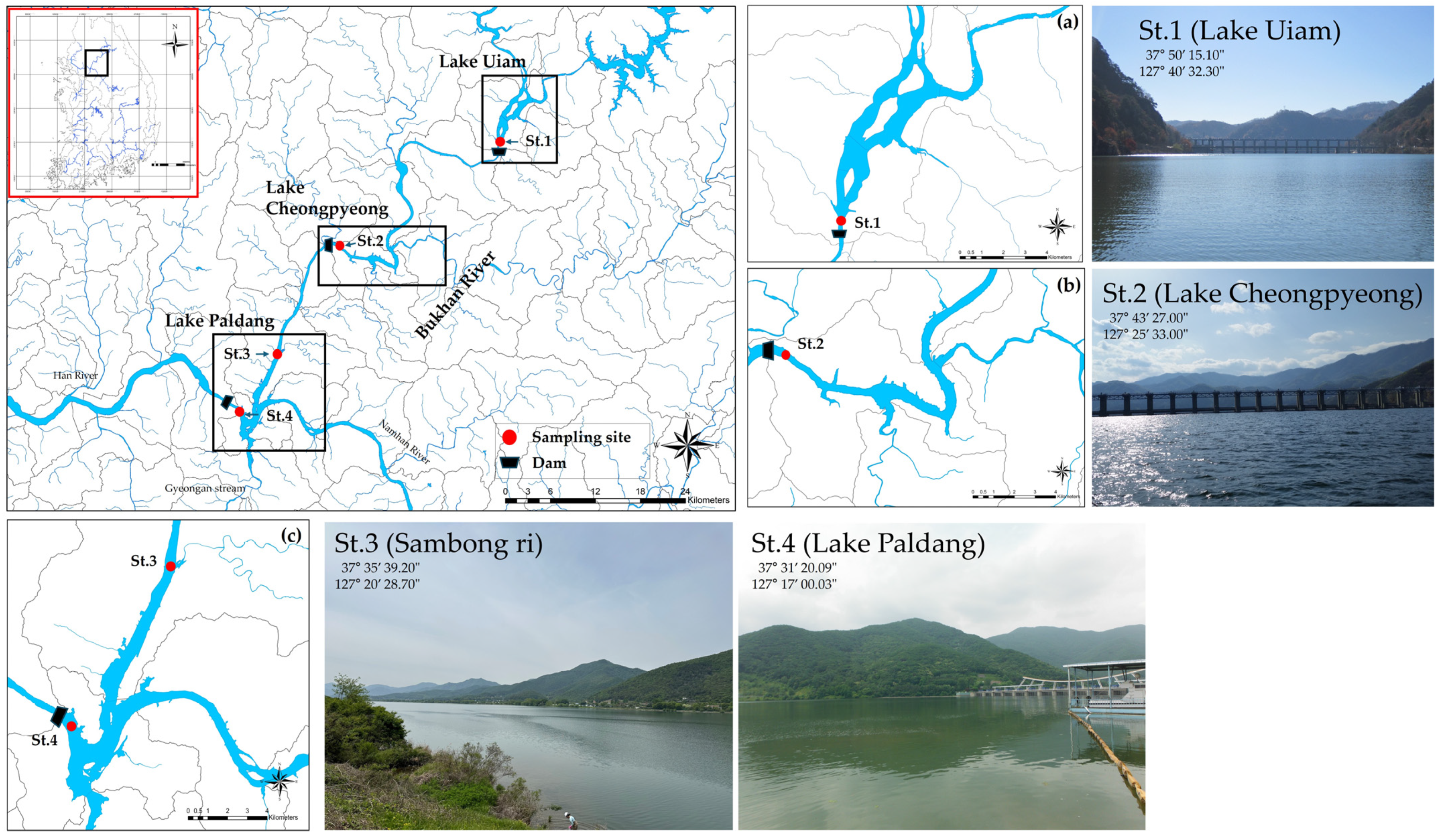
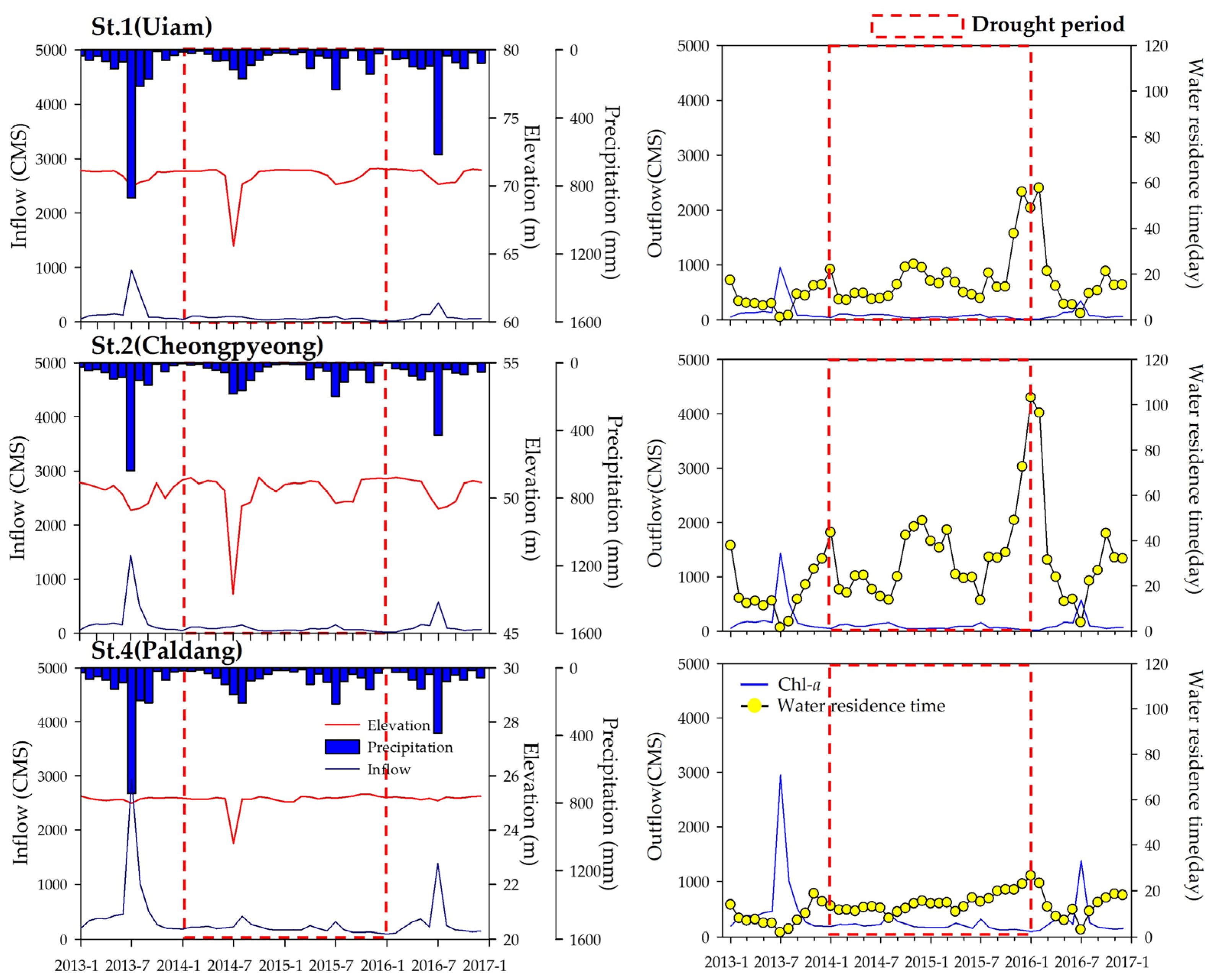
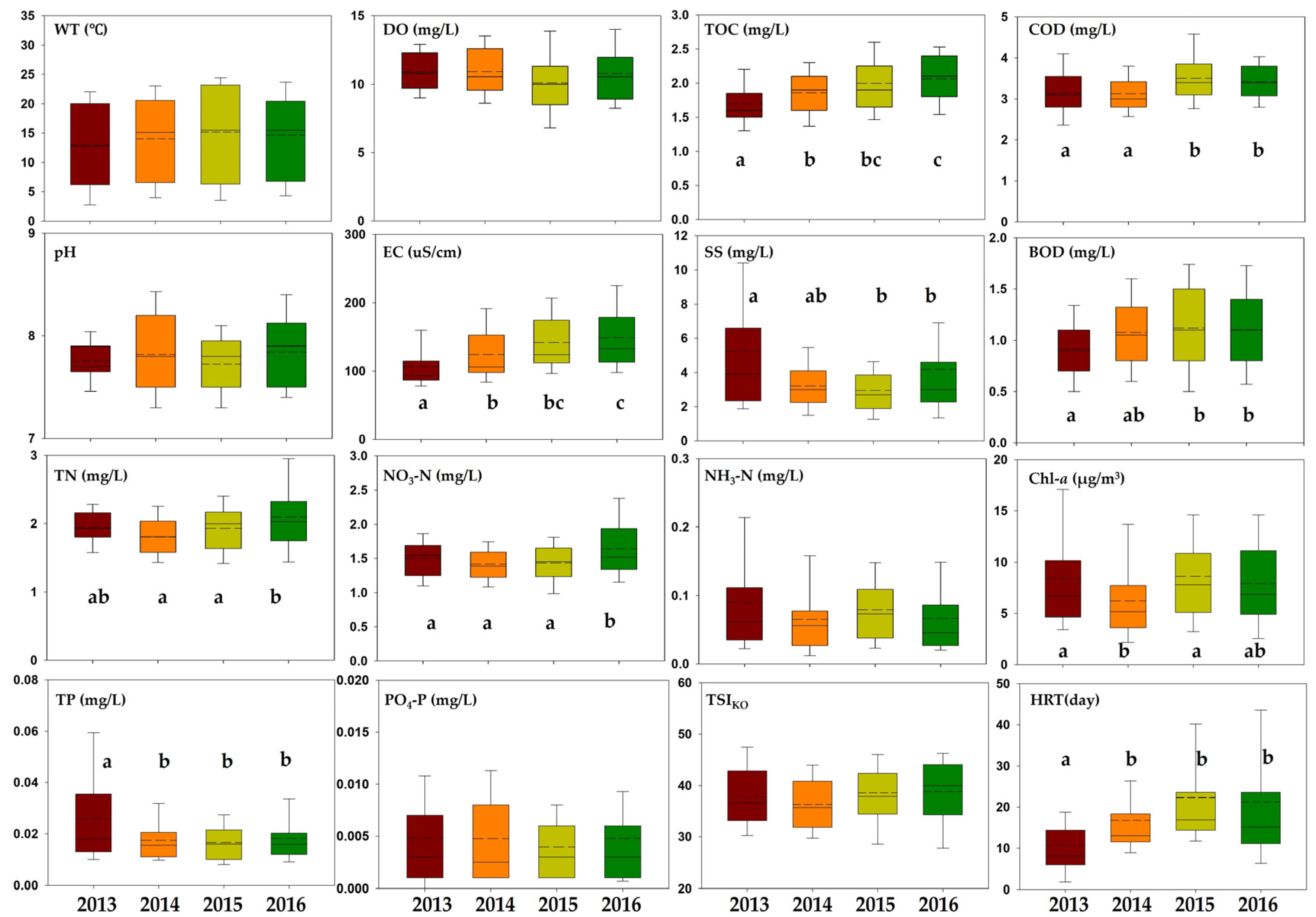
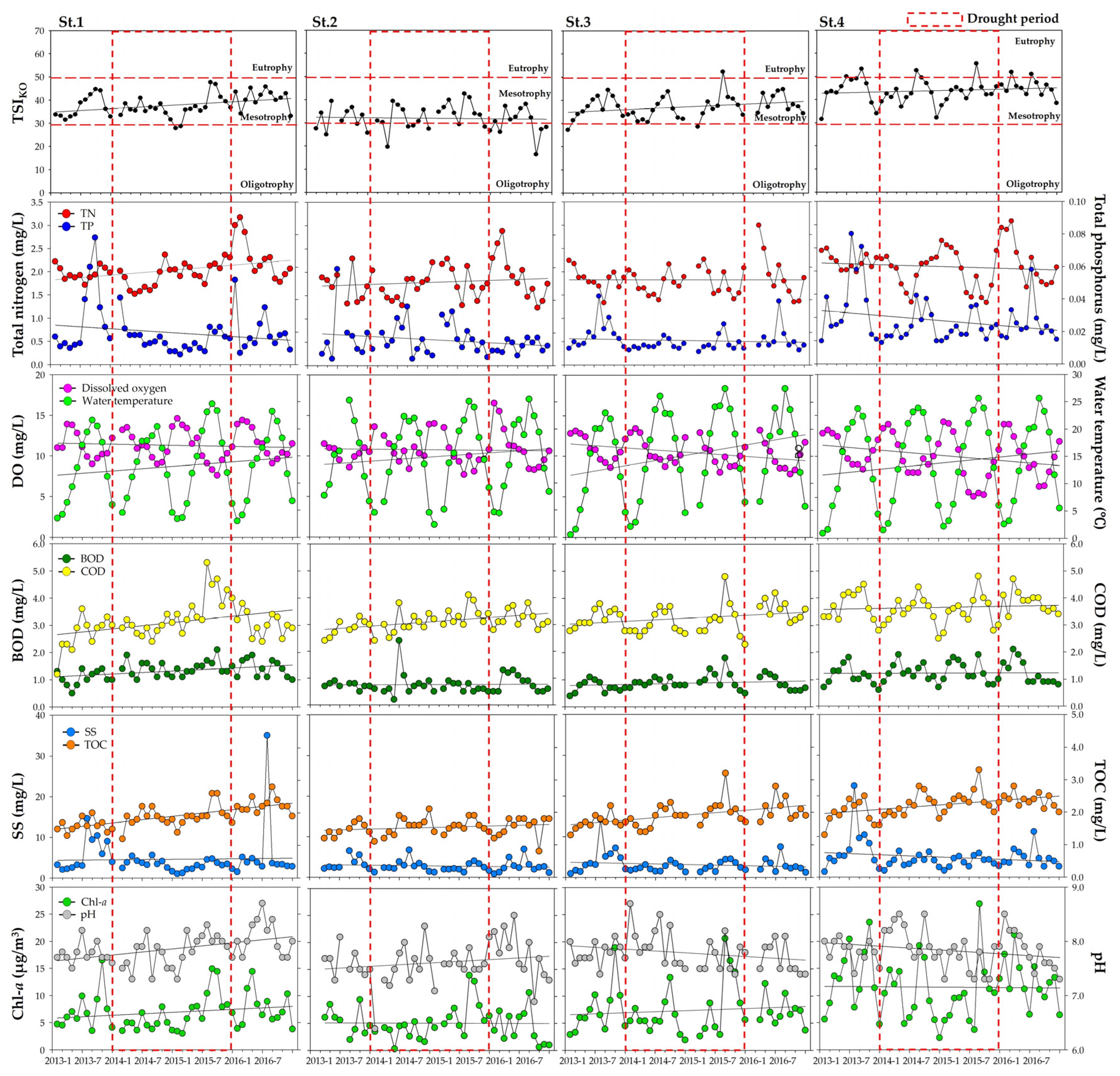
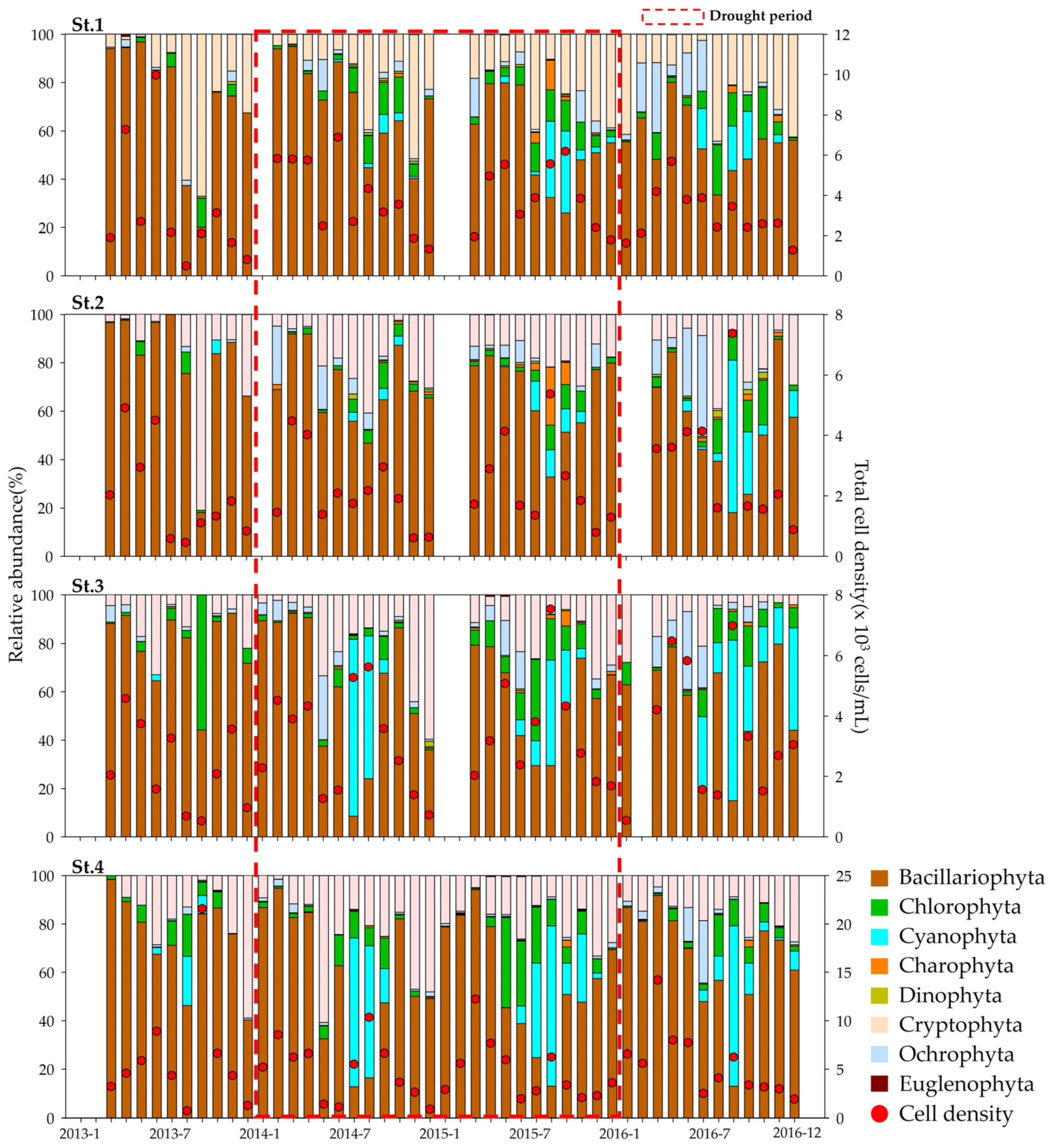
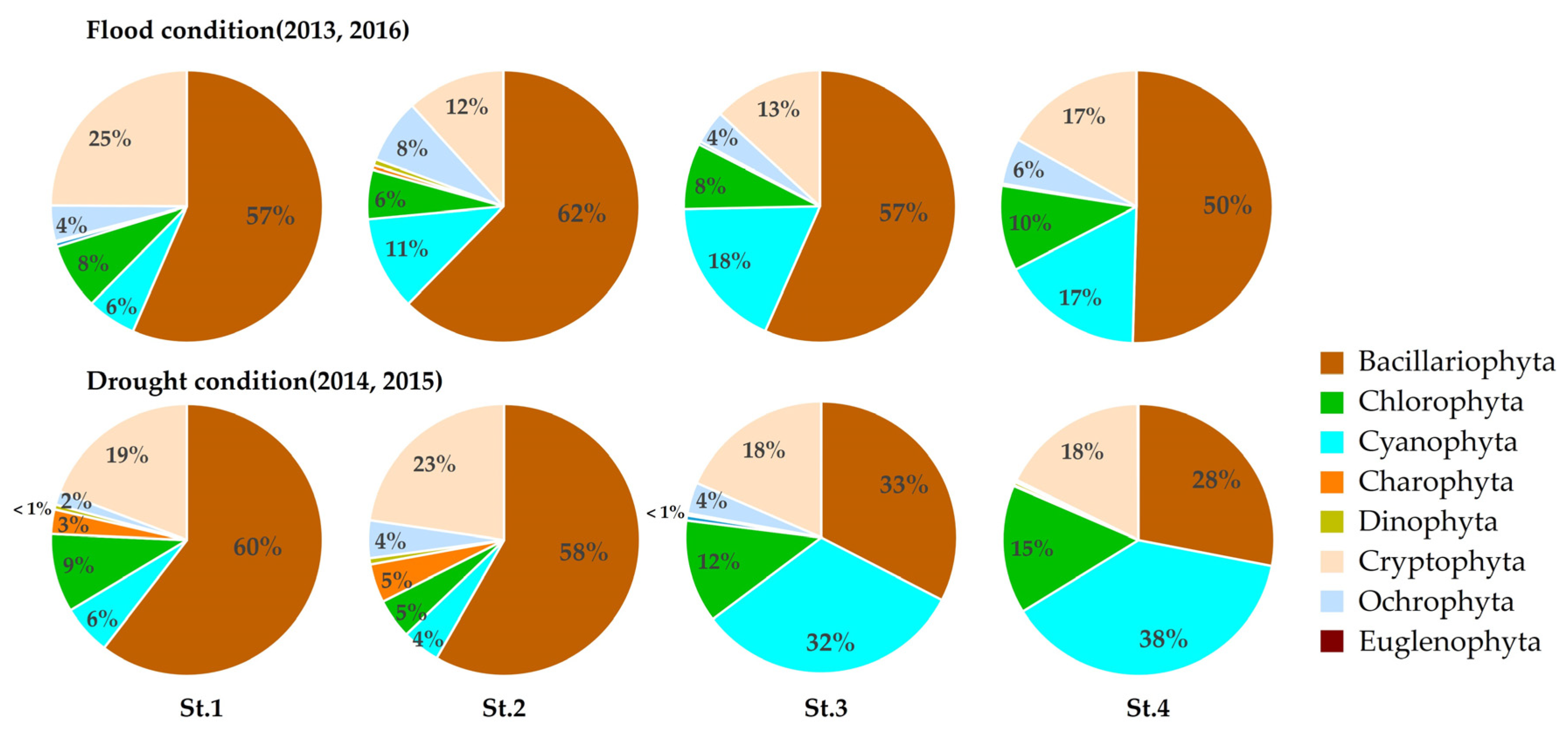

| Taxa | Species | Flood | Drought | Recovery | |
|---|---|---|---|---|---|
| 2013 | 2014 | 2015 | 2016 | ||
| Bacillariophyta | Stephanodiscus hantzschii | * | * | * | * |
| Bacillariophyta | Asterionella formosa | * | * | * | * |
| Bacillariophyta | Fragilaria crotonensis | * | * | * | * |
| Bacillariophyta | Aulacoseira granulata var. angustissima | * | * | * | * |
| Bacillariophyta | Cyclotella atomus | * | * | * | * |
| Bacillariophyta | Ulnaria acus | * | * | * | * |
| Bacillariophyta | Skeletonema potamos | * | * | * | |
| Bacillariophyta | Ulnaria delicatissima | * | * | * | * |
| Bacillariophyta | Aulacoseira granulata | * | * | * | * |
| Bacillariophyta | Stephanocyclus meneghinianus | * | * | * | * |
| Bacillariophyta | Urosolenia longiseta | * | * | * | * |
| Bacillariophyta | Discostella stelligera | * | * | * | * |
| Bacillariophyta | Pantocsekiella ocellata | * | * | * | * |
| Bacillariophyta | Aulacoseira ambigua | * | * | * | * |
| Bacillariophyta | Aulacoseira distans | * | * | * | * |
| Charophyta | Mougeotia sp. | * | * | * | * |
| Chlorophyta | Scenedesmus quadricauda | * | * | * | * |
| Chlorophyta | Micractinium pusillum | * | * | * | * |
| Chlorophyta | Chlamydomonas sp. | * | * | * | * |
| Cryptophyta | Rhodomonas sp. | * | * | * | * |
| Cryptophyta | Cryptomonas ovata | * | * | * | * |
| Cryptophyta | Cryptomonas sp. | * | * | * | * |
| Cyanophyta | Merismopedia tenuissima | * | * | * | |
| Cyanophyta | Pseudanabaena sp. | * | * | * | * |
| Cyanophyta | Dolichospermum spiroides | * | * | ||
| Cyanophyta | Microcystis aeruginosa | * | * | * | * |
| Cyanophyta | Dolichospermum circinale | * | * | * | * |
| Ochrophyta | Dinobryon divergens | * | * | * | * |
| Ochrophyta | Dinobryon sertularia | * | * | * | * |
| Taxa | WT | DO | BOD | COD | SS | TOC | pH | EC | TN | NH3-N | NO3-N | TP | PO4-P | Chl-a | TSIKO | Rainfall | WRT |
|---|---|---|---|---|---|---|---|---|---|---|---|---|---|---|---|---|---|
| Bacillariophyta | −0.275 ** | 0.383 ** | 0.380 ** | 0.109 | 0.209 ** | 0.076 | 0.208 ** | 0.096 | 0.354 ** | 0.298 ** | 0.325 ** | 0.087 | −0.120 | 0.455 ** | 0.251 ** | −0.134 | −0.267 ** |
| Cyanobacteria | 0.594 ** | −0.555 ** | 0.096 | 0.440 ** | 0.090 | 0.433 ** | −0.065 | 0.207 ** | −0.224 ** | −0.184 * | −0.220 ** | 0.115 | 0.114 | 0.216 ** | 0.318 ** | 0.201 ** | 0.090 |
| Chlorophyta | 0.601 ** | −0.510 ** | 0.374 ** | 0.432 ** | 0.361 ** | 0.518 ** | 0.101 | 0.199 ** | −0.013 | −0.062 | −0.112 | 0.253 ** | 0.124 | 0.398 ** | 0.502 ** | 0.396 ** | −0.177 * |
| Charophyta | 0.245 ** | −0.166 * | 0.122 | 0.228 ** | −0.049 | 0.200 ** | 0.013 | 0.228 ** | −0.021 | −0.083 | 0.022 | −0.141 | −0.037 | 0.109 | 0.079 | −0.049 | 0.148 |
| Dinophyta | 0.331 ** | −0.217 ** | 0.327 ** | 0.181 * | 0.171 * | 0.157 * | 0.150 | 0.167 * | 0.029 | −0.079 | −0.055 | 0.035 | 0.134 | 0.165 * | 0.151 * | 0.150 * | 0.066 |
| Ochrophyta | −0.074 | 0.200 ** | 0.235 ** | 0.004 | −0.091 | 0.060 | 0.256 ** | 0.117 | 0.169 * | 0.173 * | 0.196 * | −0.109 | −0.025 | 0.041 | 0.004 | −0.052 | −0.023 |
| Cryptophyta | 0.166 * | −0.148 | 0.477 ** | 0.340 ** | 0.255 ** | 0.446 ** | 0.198 ** | 0.350 ** | 0.334 ** | 0.033 | 0.116 | 0.293 ** | 0.085 | 0.347 ** | 0.468 ** | 0.120 | 0.006 |
| Euglenophyta | 0.007 | 0.029 | 0.149 | 0.002 | −0.049 | 0.058 | −0.035 | 0.053 | 0.112 | 0.075 | −0.017 | −0.032 | 0.082 | 0.024 | 0.022 | 0.115 | −0.031 |
Disclaimer/Publisher’s Note: The statements, opinions and data contained in all publications are solely those of the individual author(s) and contributor(s) and not of MDPI and/or the editor(s). MDPI and/or the editor(s) disclaim responsibility for any injury to people or property resulting from any ideas, methods, instructions or products referred to in the content. |
© 2025 by the authors. Licensee MDPI, Basel, Switzerland. This article is an open access article distributed under the terms and conditions of the Creative Commons Attribution (CC BY) license (https://creativecommons.org/licenses/by/4.0/).
Share and Cite
Sim, Y.B.; Im, J.K.; Park, C.H.; Byun, J.H.; Hwang, S.-J. Impact of Drought on the Aquatic Ecosystem of the Cascade Dam Reservoir in South Korea. Water 2025, 17, 1023. https://doi.org/10.3390/w17071023
Sim YB, Im JK, Park CH, Byun JH, Hwang S-J. Impact of Drought on the Aquatic Ecosystem of the Cascade Dam Reservoir in South Korea. Water. 2025; 17(7):1023. https://doi.org/10.3390/w17071023
Chicago/Turabian StyleSim, Youn Bo, Jong Kwon Im, Chae Hong Park, Jeong Hwan Byun, and Soon-Jin Hwang. 2025. "Impact of Drought on the Aquatic Ecosystem of the Cascade Dam Reservoir in South Korea" Water 17, no. 7: 1023. https://doi.org/10.3390/w17071023
APA StyleSim, Y. B., Im, J. K., Park, C. H., Byun, J. H., & Hwang, S.-J. (2025). Impact of Drought on the Aquatic Ecosystem of the Cascade Dam Reservoir in South Korea. Water, 17(7), 1023. https://doi.org/10.3390/w17071023










